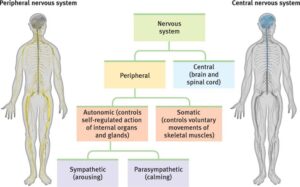Back to: Physical Health Education SS2
Welcome to today’s class!!
We are thrilled to have you in our class!!
In today’s Physical and Health Education class, we will be learning about The Nervous System II
Nervous System II

The nervous system is a complex network of nerves and cells that carry messages to and from the brain and spinal cord to various parts of the body. The proper functioning of these nerves ensures that each organ system, such as the cardiovascular, gastrointestinal, and immune systems, can adequately communicate with one another.
The nervous system includes the central nervous system (CNS) and peripheral nervous system (PNS). The CNS is made up of the brain and spinal cord, whereas the PNS is made up of the somatic and autonomic nervous systems.
- The Diencephalon
The diencephalon includes the thalamus and hypothalamus. The thalamus is a relay center for sensory data, whereas the hypothalamus transmits hormonal signals to the body through the pituitary gland.
The thalamus and hypothalamus, together with the amygdala and hippocampus, comprise the limbic system. The amygdala regulates emotion, memory, as well as the brain’s reward system, stress, and the ‘fight or flight’ response to threats.
The hippocampus, located underneath each temporal lobe, is vital for long-term memory. This structure also has a role in learning, navigation, and spatial perception.
- The Spinal Cord
The spinal cord is a long tube-like structure that extends from the brain. The spinal cord can be classified into cervical, thoracic, and lumbar areas located in the neck, chest, and lower back.
A total of 31 pairs of nerves and nerve roots comprise the spinal cord. The spinal cord region from which a pair of spinal nerves originates is called the spinal segment.
The cervical spinal cord consists of eight nerves that originate from the neck and run mainly to the face and head.
A total of twelve pairs of nerves can be found within the thoracic region of the spinal cord. These nerves allow for movements in the upper body, including extension of the chest, upper back, and abdomen.
- Neurons
The neuron, the basic unit of the nervous system, is a specialized conductor cell that receives and transmits electrochemical nerve impulses between the brain and the rest of the nervous system.
A neuron consists of a cell body, dendrite, and axon. The cell body contains the nucleus, which controls cellular activities and contains genetic material.
Dendrites are branched projections that extend from the cell body and receive signals from other neurons.
Electrical signals travel down a long and thin process known as an axon, which extends from the cell body. These chemical signals, more commonly referred to as neurotransmitters, travel between neurons through a space known as the synapse.
Sensory neurons carry signals from sensory receptors to the brain, whereas motor neurons carry signals from the brain to other nerves, muscles, and glands. The third class of neurons includes interneurons.
The myelin sheath insulates neurons and is continuous along the axons or dendrites, except at the nodes of Ranvier. Myelin, which consists of fat and proteins, provides protection to the neuron, propagates electrical impulses between neurons, and maintains the strength of the signal as it travels down the axon.

The Somatic Nervous System
The somatic nervous system (SNS) consists of peripheral nerve fibers that carry sensory information or sensations from peripheral organs to the CNS. The SNS also includes motor nerve fibers that exit the brain to carry commands for movement to the skeletal muscles.
For example, upon touching a hot object, sensory nerves carry information about the heat to the brain. Subsequently, the brain, through motor nerves, commands the hand muscles to withdraw it immediately. This process takes less than one second to complete. The neural cell body that carries this information often lies within the brain or spinal cord and projects directly to a skeletal muscle.
The Autonomic Nervous System
The autonomic nervous system (ANS) controls the nerves of the body’s inner organs that cannot be controlled consciously. The ANS can be further subdivided into the sympathetic, parasympathetic, and enteric nervous systems. Some of the different activities controlled by the ANS include the heartbeat, digestion, subconscious breathing, blood pressure, and sexual arousal.
Evaluation
What is the Nervous System?
Reading Assignment
Explain the functions of the Somatic Nervous System.
Weekend Assignment
Explain the role of the Neurons in the body.
We hope you enjoyed today’s class. In our next class, we will be focusing on Revision.
Let us know your thoughts and questions in the comment section, and we will attend to them as fast as we can.
